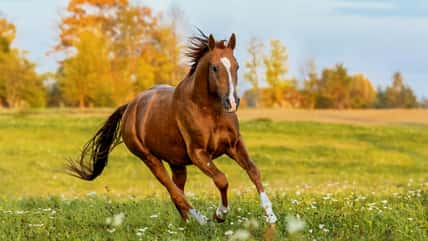A 200-Year-Old Rock Painting May Depict A Strange Tusked Creature That Lived In The Region Over 260 Million Years Ago

The San people of South Africa painted a battle scene on a sandstone cliff wall between 1821 and 1835.
The 200-year-old rock painting is called the Horned Serpent panel. It depicts spears, warriors, various known animals, and a strange tusked creature with a long, curved body and polka dots on its skin. The creature does not resemble any living species.
A paleontologist from the University of the Witwatersrand in Johannesburg named Julien Benoit has suggested that the tusked animal might be a recreation of the extinct dicynodont, which lived in the region more than 260 million years ago.
Dicynodonts were ancestors of mammals, although they looked more like reptiles and had beaks and tusks. They shared the planet with the earliest dinosaurs and went extinct about 200 million years ago. So, they died out long before the San people or any other humans could’ve seen them.
But dicynodont fossils are abundant in the Karoo Basin in south-central Africa. The basin contains the well-preserved fossils of many species.
Since the San people were known to include features of their environment in their art, the Horned Serpent was likely inspired by fossil remains of the dicynodont.
The painted image of the creature clearly portrays tusks, and the polka dots may represent its bumpy skin, which has been preserved on some fossils.
The curve of the animal’s spine also resembles the fossil arrangements of dicynodonts. The new study could change the timeline of the dicynodont’s discovery.
“The painting was made in 1835 at the latest, which means this dicynodont was depicted at least 10 years before the Western scientific discovery and naming of the first dicynodont by Richard Owen in 1845,” Benoit said. “This work supports that the first inhabitants of southern Africa, the San hunter-gatherers, discovered fossils, interpreted them, and integrated them into their rock art and belief system.”

wolfavni – stock.adobe.com – illustrative purposes only
The Indigenous people of South Africa likely knew about the dicynodont before Westerners did. San myths even tell of large animals, bigger than elephants or hippos, that once roamed southern Africa.
The dicynodont might have had spiritual meaning and was purposely portrayed as part of a cultural ceremony because it was extinct.
“During rain-making ceremonies, the San enter a state of trance and enter the realm of the dead to catch rain animals and bring the rain back to the world of the living,” said Benoit.
“By picking a species, such as a dicynodont, that they knew was extinct and thus dead, they likely hoped this rain-animal had some increased potency to bridge the two worlds.”
Benoit added that imagination was not a source of the artwork since the San people only painted things they saw around their environment, whether it was fossils or natural characteristics of the landscape.
The study was published in PLOS One.
Sign up for Chip Chick’s newsletter and get stories like this delivered to your inbox.
More About:News





